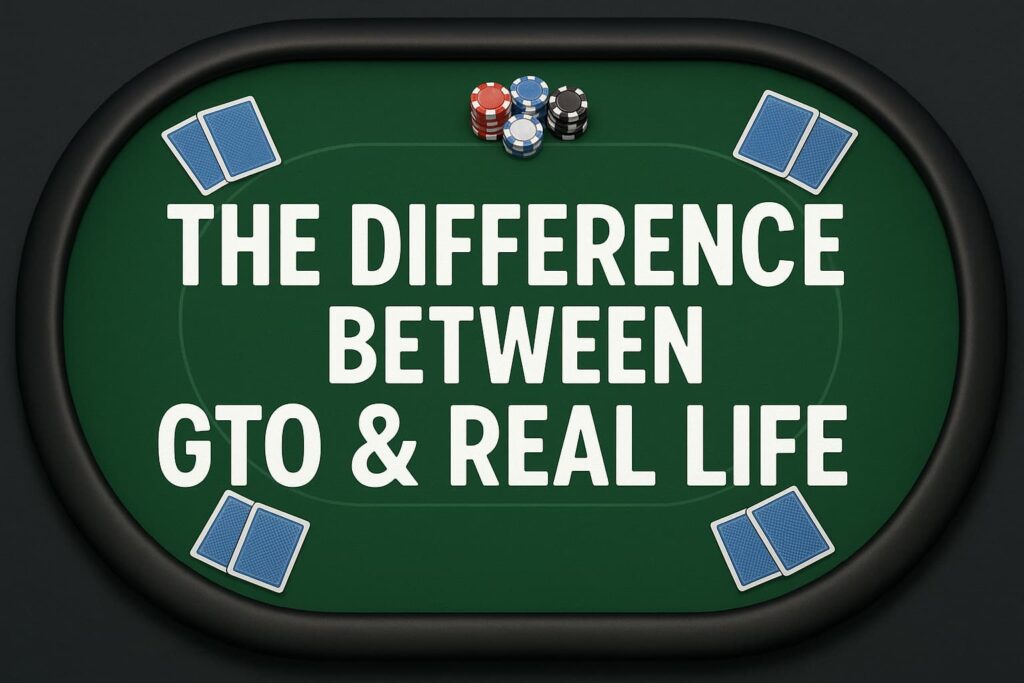The path to becoming a formidable poker player often leads to the study of Game Theory Optimal (GTO) play. But what separates a theoretical GTO wizard from a real-life crusher? The distinction lies in understanding the nature of your opponents and adapting your strategy to maximize profit. While GTO provides a fundamentally sound baseline, the real money is made in the nuances of human play.

GTO vs. Real-Life Opponents: The Human Factor
At its core, GTO poker represents a perfect, machine-like strategy. It’s a theoretical framework where players are flawless. However, the felt of a real poker table, whether live or online, is a far cry from this perfect model. It’s populated by humans who are prone to making mistakes and deviating from a strict GTO approach. This is the fundamental difference: GTO is theoretical, while real-life poker involves capitalizing on human error.
Profit Maximization: GTO vs. Exploitation
While a solid understanding of GTO is invaluable, the most significant profits in poker don’t come from perfectly mimicking a GTO solver. Instead, they come from a process of exploitation. The key is to first identify where your opponents deviate from GTO and then adjust your strategy specifically to take advantage of those tendencies.
From Indifference to Clear Decisions
One of the most powerful applications of this exploitative approach is how it transforms “indifferent” hands.
- In GTO, an indifferent hand is one where the expected value (EV) of two different actions, like calling or folding, is roughly zero in the long run. It theoretically doesn’t matter which you choose.
- In real life, these situations rarely remain neutral. Even a slight, predictable deviation in your opponent’s strategy can shift an indifferent GTO spot into a very clear call or a clear fold, creating a significant opportunity for profit. An Ace-Jack hand that might be a break-even call according to GTO can easily become a very profitable call in a real game.
Adapting to Real-Life Play: Key Estimations
To make these profitable adjustments, you need to constantly estimate how your opponents’ strategies differ from a GTO baseline. Two critical questions to ask yourself are:
1.How Easy Is It to Bluff?
GTO dictates very specific hands and frequencies for bluffing. In practice, however, many players get this wrong. Population data from midstakes games shows that the average regular actually bluffs more often than GTO recommends. Players might over-bluff with good bluffing candidates, perhaps knowing that their opponents won’t call at the correct GTO frequency. Even a small uptick in an opponent’s bluffing frequency—as little as 1.5 percentage points—can turn a GTO-indifferent hand into a highly profitable call.
2.How Often Does Your Opponent Value Bet?
The other side of the coin is the value-to-bluff ratio. A balanced GTO strategy maintains a healthy number of bluffs relative to value hands. While you might think an opponent who bluffs more could still be balanced if they also value bet more, this is often not the case.
Midstakes population data reveals a crucial tendency: players not only bluff more than GTO but also value bet less often. This skews their value-to-bluff ratio significantly lower. For instance, a GTO simulation might have a player jam overpairs for value 100% of the time in a certain spot. In reality, the average player will make that value bet far less frequently, narrowing their value range.
When an opponent simultaneously bluffs more and value bets less, a GTO-indifferent call becomes incredibly lucrative. The EV of calling with that Ace-Jack hand, for example, could potentially double from what it would be against an opponent who was only over-bluffing.
The Bottom Line
In summary, the key difference between GTO and real-life poker is the gap between perfect theory and human reality. GTO assumes flawless opponents and creates situations where certain hands are merely break-even. Real-world poker, especially at the midstakes, is defined by opponents’ human tendencies—like bluffing too much and value betting too little. By recognizing and attacking these predictable flaws, you can transform indifferent, marginal spots into clear, highly profitable calls. While this becomes more of an estimation game at high stakes, it remains a crucial skill for profitability.

If your opponents are not versed in GTO play, how can u as a student of GTO exploit them?